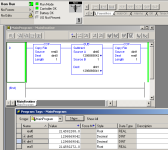The attached pdf shows a CPT instruction that should calculate the value of tag Cell_Charge_Percent_Remaining[1]. I've included the relevant monitored REAL tag values to demonstrate that they are all non-zero.
Apart from an initial result when (for example) the value of the tag Initial_Mass_kg is changed, the calculation result remains static. Is this a case of too small a change in the tags' values -given the high initial result- when the tag Cell_I_x_t[1] increments? From searching posts here, I understand that a REAL of value >7,000,000 will not increment/decrement by 1, and at the time the screen shots were taken, the change per second would have been 0.000847
Have I answered my own question?
BTW, I checked the result with a calculator, which came out as 214,592,274.678, not the program's result of 214,592,288.0
Thanks.
Apart from an initial result when (for example) the value of the tag Initial_Mass_kg is changed, the calculation result remains static. Is this a case of too small a change in the tags' values -given the high initial result- when the tag Cell_I_x_t[1] increments? From searching posts here, I understand that a REAL of value >7,000,000 will not increment/decrement by 1, and at the time the screen shots were taken, the change per second would have been 0.000847
Have I answered my own question?
BTW, I checked the result with a calculator, which came out as 214,592,274.678, not the program's result of 214,592,288.0
Thanks.





